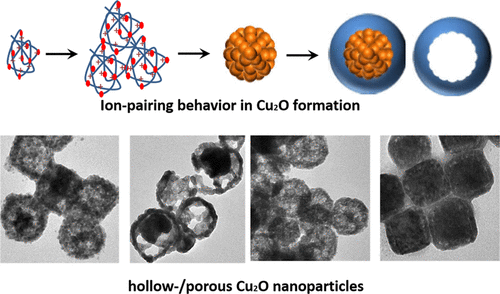Our official English website, www.x-mol.net, welcomes your
feedback! (Note: you will need to create a separate account there.)
The Synthesis of Hollow/Porous Cu2O Nanoparticles by Ion-Pairing Behavior Control.
ACS Omega ( IF 3.7 ) Pub Date : 2020-01-23 , DOI: 10.1021/acsomega.9b03380
Xiaohui Song 1, 2, 3 , Weichang Xu 2 , Dongmeng Su 2 , Jing Tang 4 , Xiaotao Liu 1
ACS Omega ( IF 3.7 ) Pub Date : 2020-01-23 , DOI: 10.1021/acsomega.9b03380
Xiaohui Song 1, 2, 3 , Weichang Xu 2 , Dongmeng Su 2 , Jing Tang 4 , Xiaotao Liu 1
Affiliation

|
Owing to the properties of low density, large surface areas, excellent loading capacity, high permeability, and interstitial hollow spaces, hollow nanostructures have been widely applied in many important research fields, such as catalysis, drug-controlled release, confined synthesis, optics and electronics, and energy storage. This work provided a simple platform for hollow Cu2O nanostructure synthesis based on the surfactant controlling methodology, which is under the supposed mechanism of ion-pairing behavior at the initial nucleation stage. Thus here, we explore our system in two different directions: (1) we get different types of hollow Cu2O nanoparticles by controlling the surfactant concentration during the synthesis step in colloids, which is critical to the novel structure design and potential application in many different areas and (2) we explore the method to Cu2O hollow particle synthesis to test the hypothesis of the ion-pairing behavior during the initial nucleation by tuning the solvent ratio, cation concentration (such as NH4NO3 addition amount difference in the synthetic step), and selective etching. By tuning the synthetic conditions as well as designing control experiments, we hope to provide a solid understanding of the crystal growth mechanism. Our improved understanding in similar systems (both Cu2O and ZnO systems) will make it easier for interpreting nanostructure formation in new discoveries and, more importantly, in rationally designing various complex nanostructures based on a bottom-up strategy.
中文翻译:

通过离子对行为控制合成空心/多孔 Cu2O 纳米粒子。
中空纳米结构由于具有低密度、大比表面积、优异的负载能力、高渗透性和间隙空心等特性,在催化、药物控制释放、限域合成、光学和化学等许多重要研究领域得到了广泛的应用。电子和能源存储。这项工作为基于表面活性剂控制方法的空心 Cu2O 纳米结构合成提供了一个简单的平台,该平台是在初始成核阶段离子对行为的假设机制下进行的。因此,在这里,我们从两个不同的方向探索我们的系统:(1)通过在胶体合成步骤中控制表面活性剂浓度,我们得到不同类型的空心 Cu2O 纳米颗粒,这对于新颖的结构设计和在许多不同领域的潜在应用至关重要(2)我们探索了Cu2O空心粒子的合成方法,通过调整溶剂比例、阳离子浓度(例如合成步骤中NH4NO3添加量的差异)和选择性来测试初始成核过程中离子对行为的假设。蚀刻。通过调整合成条件以及设计控制实验,我们希望对晶体生长机制有一个扎实的了解。我们对类似系统(Cu2O 和 ZnO 系统)的进一步了解将使我们更容易解释新发现中纳米结构的形成,更重要的是,基于自下而上的策略合理设计各种复杂的纳米结构。
更新日期:2020-02-04
中文翻译:

通过离子对行为控制合成空心/多孔 Cu2O 纳米粒子。
中空纳米结构由于具有低密度、大比表面积、优异的负载能力、高渗透性和间隙空心等特性,在催化、药物控制释放、限域合成、光学和化学等许多重要研究领域得到了广泛的应用。电子和能源存储。这项工作为基于表面活性剂控制方法的空心 Cu2O 纳米结构合成提供了一个简单的平台,该平台是在初始成核阶段离子对行为的假设机制下进行的。因此,在这里,我们从两个不同的方向探索我们的系统:(1)通过在胶体合成步骤中控制表面活性剂浓度,我们得到不同类型的空心 Cu2O 纳米颗粒,这对于新颖的结构设计和在许多不同领域的潜在应用至关重要(2)我们探索了Cu2O空心粒子的合成方法,通过调整溶剂比例、阳离子浓度(例如合成步骤中NH4NO3添加量的差异)和选择性来测试初始成核过程中离子对行为的假设。蚀刻。通过调整合成条件以及设计控制实验,我们希望对晶体生长机制有一个扎实的了解。我们对类似系统(Cu2O 和 ZnO 系统)的进一步了解将使我们更容易解释新发现中纳米结构的形成,更重要的是,基于自下而上的策略合理设计各种复杂的纳米结构。


































 京公网安备 11010802027423号
京公网安备 11010802027423号